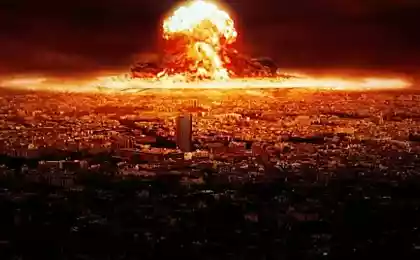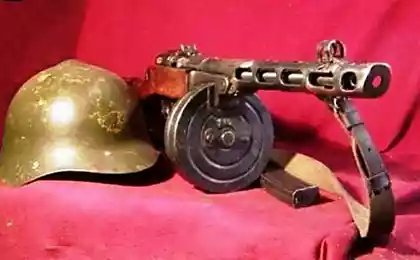1648
12 floors underground in the event of nuclear war ...
About the place I first heard in the fall, and since then very much like to go there.
A few days ago, we made a trip to this once top-secret facility, from which was to be launched nuclear missiles in the event of the Third World.

The military part looks deserted, the gates are open, but the road fresh traces of the tread. We go inside.

Hall of Fame. 40 years, this part of the protected world.

6. Construction of a room where a kitchen, barracks, the top has a glass bunker.
Penetrates through the open window.
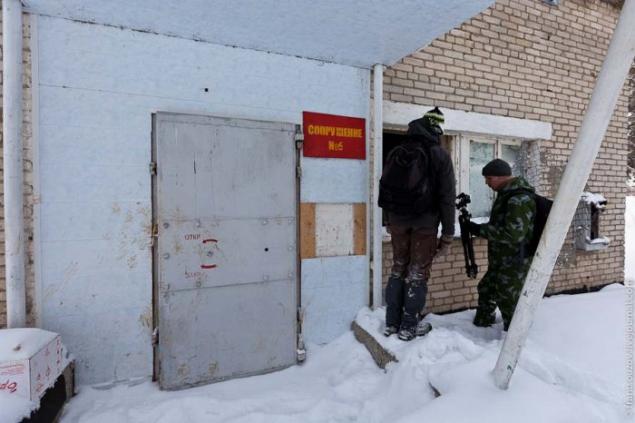
We pass through the building, past the rooms where once lived the military. At the end of the building - wooden door with a modest sign "Poterna №1» and stairs down. On the wall - arrow indicating the direction of the UE. Somehow even uninteresting.
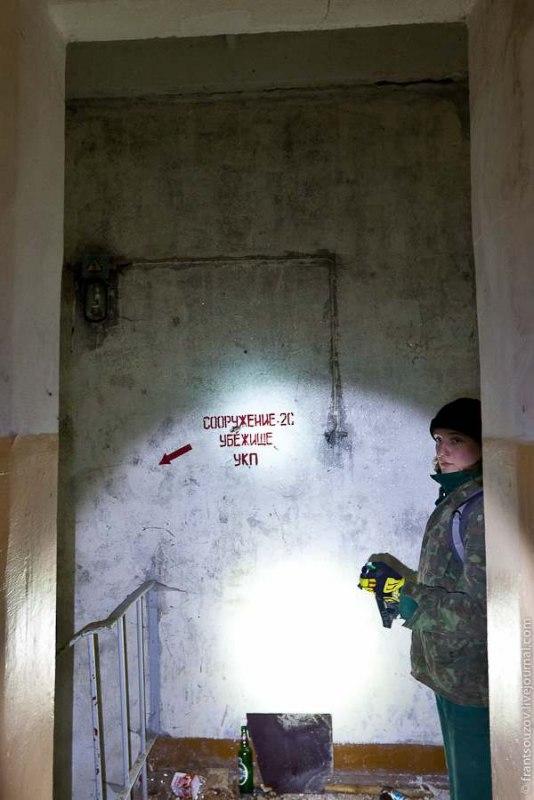
We go down, open the iron germodver and go further.

But it is not so simple. The corridor is flooded, then the depth of the water is waist-deep, especially not some fun ...
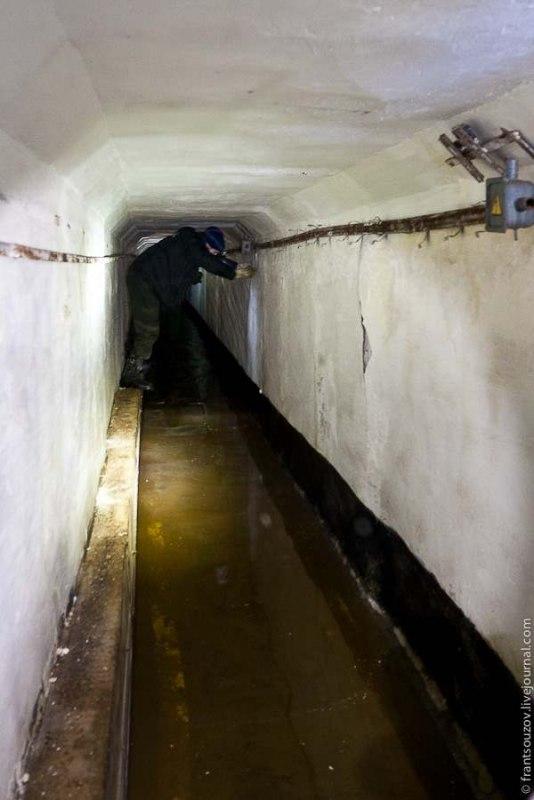
We rise to the surface and decide to look for another entrance. First we decided to check the guardhouse (right in the center, with a "glass" on the roof).
On the territory of many open technological wells and ventilation shafts, sprinkled with snow. We go to the track-to-track, testing the ground with a stick in front of him.
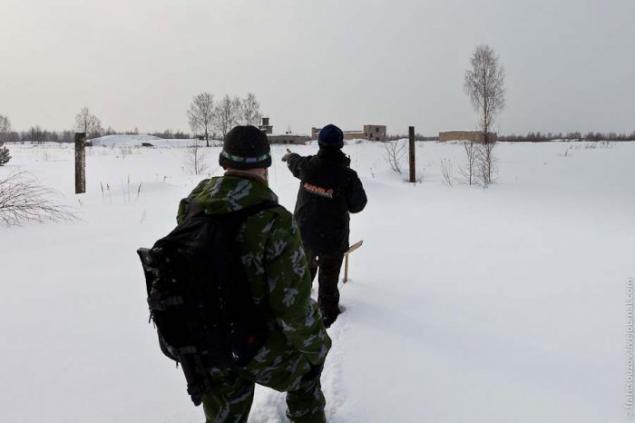
The guardhouse is equipped with a sauna with a swimming pool.

Then we come to the entrance to the shelter.

Inside, nothing particularly interesting, everything is "made to us."

The building unit, nourishes all of the electricity.

The equipment was taken for a long time.

Nearby are containers with diesel fuel for generators.

Moving around the territory. Periodically sink into the snow up to his waist, once almost got into a ventilation shaft (accidentally passed twenty centimeters from the edge).

Next in line - building №5, «room operator." House with no doors, only one window. In the ceiling hatch on the right can be seen the top, and down when something went staircase. Dilema - down right now, or to find another entrance.

Next door stands sentry point with a machine gun. However, to kazhy not just take off the internal alarm remeters was built underpass. In the semi - wooden hatch under it - round metal. However, since the construction is crooked - it is impossible to open it.
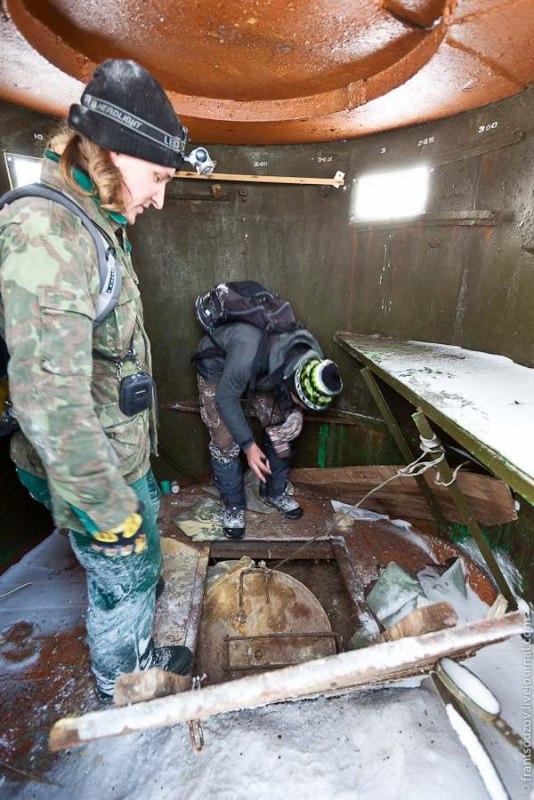
Well, there is only an inconspicuous "shed" at the bottom of the hill, from which we have just descended. We go into it.
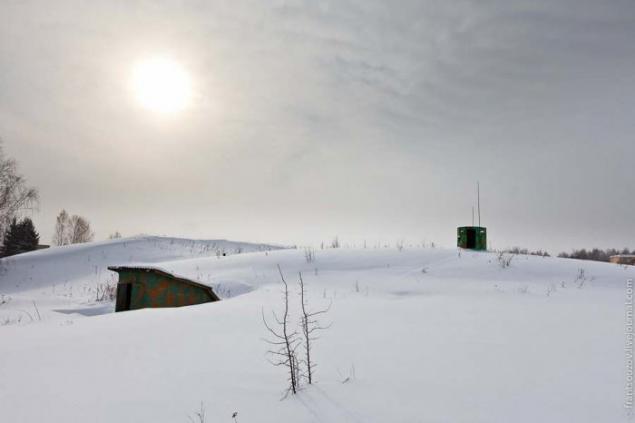
Stairs down.

There awaits us germodver, corridors and some office space.

We go to one of them. The concrete platform suspended from the ceiling to the powerful shock absorbers feet from the floor.

This is to ensure that the equipment is located here, not out of order as a result of the shock wave.

Wardrobe and shock better. Fasteners such capital. I think we're on the right track.
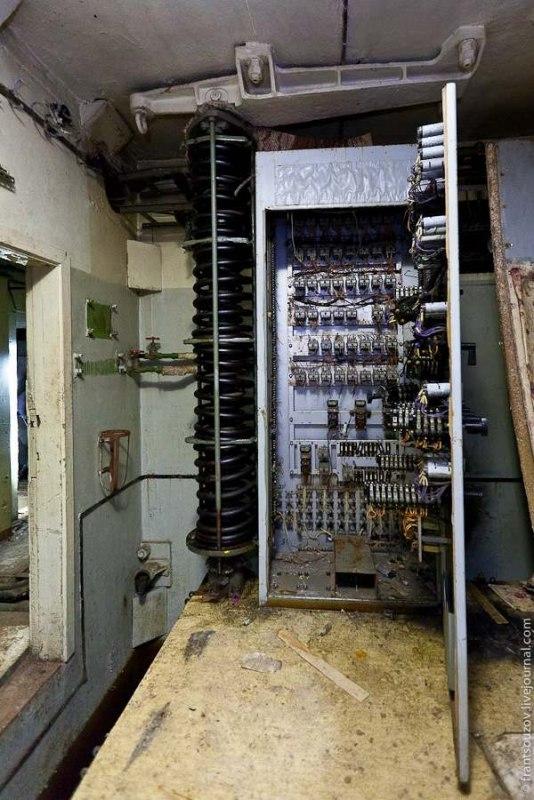
Plates are suspended over the water, the surface of which is painted with chemistry in all colors of the rainbow.

Again inspection gallery. Go ahead.

Severe "military" snowdrift. Ironically, it was just a ruined building Refrigeration Center.

For normal operation of equipment required significant cooling, because next to the gearbox is a huge building with air conditioning and heating system in winter. In the case of the destruction of the building, air conditioning, cooling equipment is taken offline, this advance is frozen 35 tons of ice, a kind of cold accumulator.
Making his way through the debris to fall into another corridor, which lies on the floor tiles. You're a little bit!
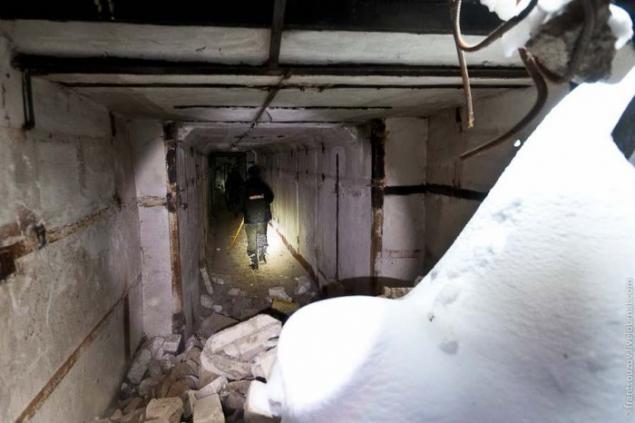
At the end of the corridor - the first germodver. The inscription - not to take offense if caught.

Behind it - the second germanium, even more powerful, that once locked actuators.
Before the trip, we read that some freaks installed at the entrance of a homemade banner, on which someone was blown up. So it is necessary to open the door with extreme caution ...

For the second herma is a third, and after it - a "bridge" leading to cover PPC !!!

To understand what this Mahina - this photo from Ukrainian Museum of Strategic Missile Forces.
The command post was used for the management and control of launchers of intercontinental ballistic missiles 15A35 (NATO classification - SS-19 "Stiletto"), maintaining the temperature and humidity conditions, and protection of personnel from the damaging factors of WMD.
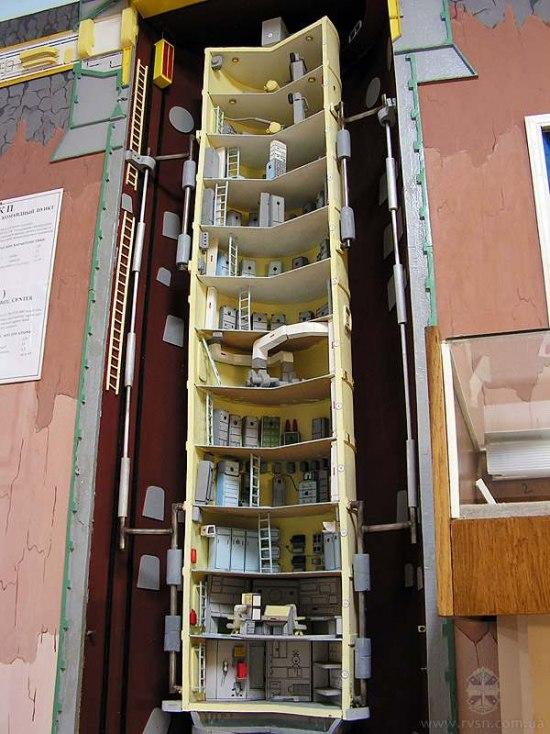
PPD is a standard missile silos depth of about 40 meters, within a 12-storey "building" metal capsule length 33 and a diameter of 3, 3 meters, suspended on vertical and horizontal shock absorbers.

"Ahrenet can!»
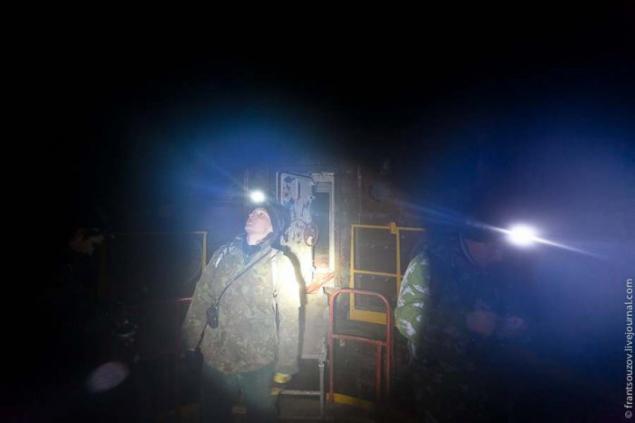
We are located on the "roof" of the capsule. The walls of many niches here and there are technological shaft leading to the surface. Some of them have served to communicate with the "outside world."

The command post of the regiment led by ten missiles, mine-launchers (MSE) which is on a distance of 8-10 km from each other.
The point has been linked with cables still 9 points that make up the division. Communication with the headquarters, district, Moscow carried out by means of a terrestrial antenna, ground antenna, and another backup cable underground antenna size of 100x100 meters, a buried under the ground to a depth of one meter. The launch can be done from anywhere in the division, district or from Moscow - depending on the situation.

Directly below me - 12 floors of the capsule, leaving the ground. Height is very rather big!

On the wall hangs a lot of stairs, some stationary, some with hooks above - portable. This is to ensure that in the event of a collapse of one or more fixed ladders in personnel still left open the possibility to get to the surface through an emergency exit hatch.
Well, we begin the descent!

Capsule is made in Leningrad, the site delivered fully assembled, except for sections 1 and 2 (equipped with diesel generators), which were transported separately in a vertical position.

All of this gigantic machine of hung on the walls of just such high-power cables, shock absorbers.

The third compartment. Each level - a round room in which the equipment safely carry out their functions in any conditions of the environment. It once housed communications equipment.

Down here is such a temporary staircase. In the fourth compartment was a system of automatic control and monitoring.

But as you have seen, "the world," the inhabitants of the capsule - the door just a narrow metal track leading along the circumference of the shaft.

We go down even lower.

In the fifth compartment is also in communication equipment.

Cabinet hardware.
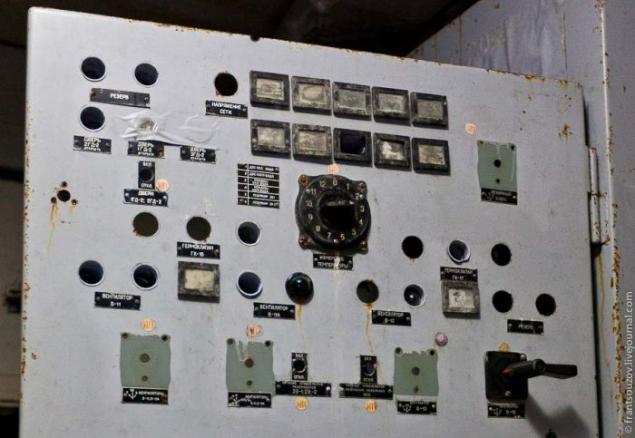
Again down.

With all the responsibilities entrusted to the UE requirements it was also very high. The design has been able to withstand a direct hit of a nuclear warhead.
In that case, two officers who were on duty (and in the conditions of a real threat of war, or "elevated" readiness - three) had the opportunity to gain a foothold in a chair, as in the plane.
Technical excellence ensures livelihoods SAR personnel and combat missions for launching missiles in all conditions. There's even a standalone mode of operation in the event of failure of the external power supply.
People could be buried up to 45 days - it was at the command post of supply of food, equipment and other special equipment needed in an emergency.
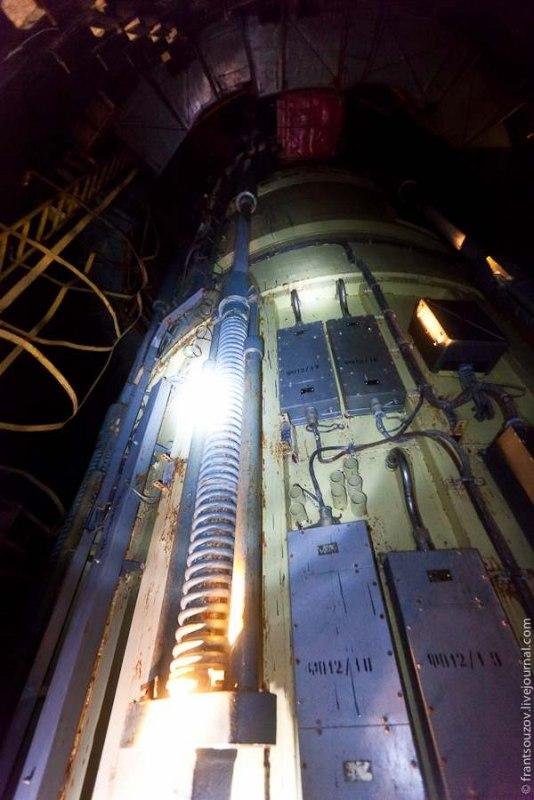
At 6, 7 and 8 are located inside the power supply apparatus ensuring all objects UE and outside were attached compressed air cylinders.
According to one version, they were intended to breathe personnel - those who are "lucky" to survive to strike back at the enemy.

According to another - compressed (which is compressed and not liquefied) air used for pneumatic control mechanisms.

9 and 10 levels - the equipment to ensure the combat missile launches.

Outside are kilometers of wires, much has been injury.
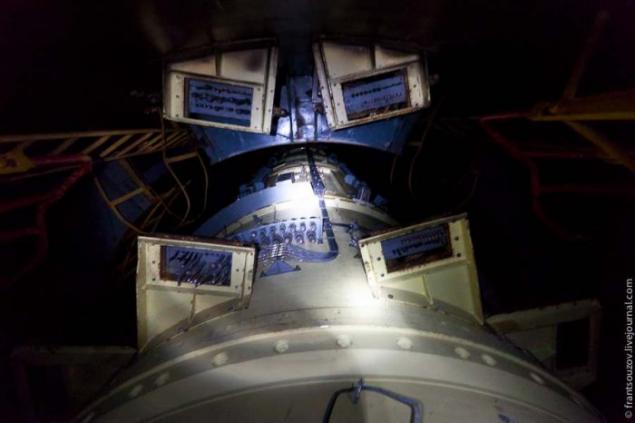
If you look to the right of the yellow ladder guides are visible - once there was a lift (as it is seen on the model) by means of which you can get to any floor of the capsule.

And now, when there is no elevator, it is necessary to move in this way.

We continue downhill.

Cylinder pressure - 400 atmospheres. Very, very much!

The bottom can already be seen. We are thinking about how to go down even lower.

Well, almost the bottom. We see a lot of shock absorbers supporting and lying on the floor trash and fittings.

11 level - the command post to battle stations, remote control and monitoring of ASBU and communication. Here's how it looked once (Photo from the site of the museum).
In the last (twelfth) level is the lounge on duty shift.
Three fighting crew command post missile regiment on duty there at 6:00 clock. During this time, they had to constantly keep track of all the changes on the display of combat control.
Launch rocket could at least 2 people, as it was necessary to simultaneously rotate the two keys to unlock the main and secondary remote.

Here's how PPC looked from above - 120-ton lid seals the mine shaft and protect the capsule from the damaging effects of nuclear weapons.
Nearby there are several technological holes for emergency exit hatch and antenna connection.

Backup satellite communications antenna near the lid missile silo at the Museum of Strategic Missile Forces.
In the case of destruction of a rocket could launch several backup methods:
- Via a wired connection to another UE.
- If the cable is damaged, via satellite from another UE via the antenna Z (pictured).
- If this is damaged satellite, behind it there is another backup, disguised, large diameter.
- If all the links are damaged - in manual mode, directly from the silo. Near the mine there is a hatch with an electronic combination lock. An officer could go down into the mine through the door and give the command to start. The launch was carried out in 5 minutes after the command.
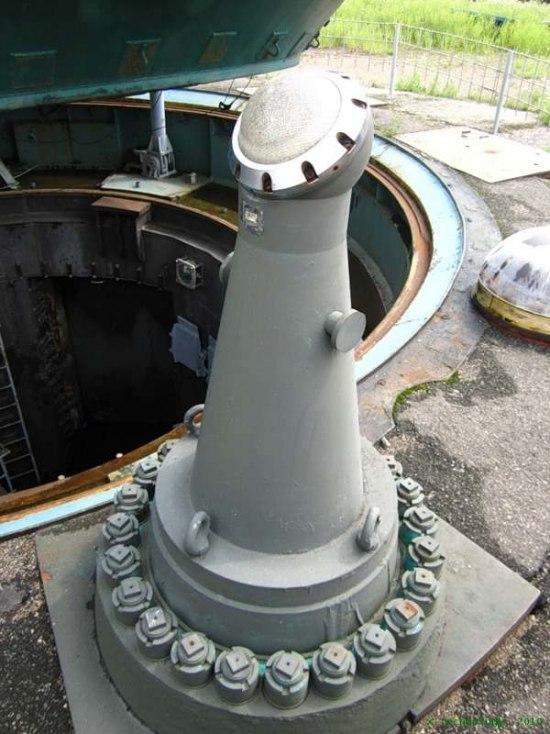
Another antenna (pictured was she) appeared after the modernization of the complex and served as a signal for making the start command missiles (Perimeter System - implementation of the "Doomsday Machine»).
In the event of a massive attack it was able to decide on a retaliatory strike on their own, without (or with minimal) human.
Upon receiving the signal from the system of missile warning, the first person in the country could activate the "Perimeter" and calmly expected developments, while being in full confidence that even the destruction of all who have the authority to bestow the command of the response to the attack, could not prevent the blow retribution.
The existence of such a system is sometimes referred to as immoral, but it is essentially the only deterrent to giving the real guarantee of failure of a potential enemy from the concept of a devastating pre-emptive strike.
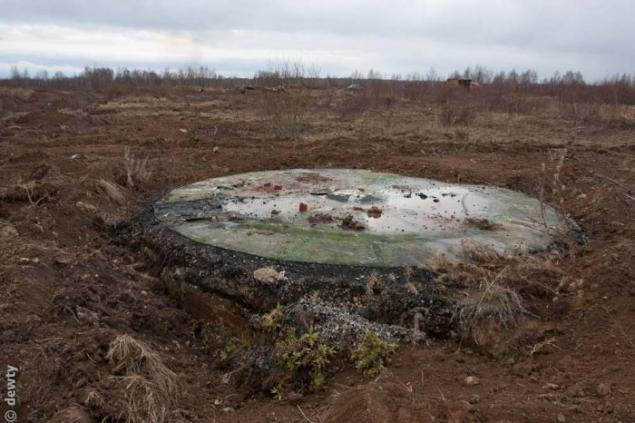
Bottom view.
125 tons. 33 meters. 45 days battery life, regardless of what is happening on the surface. And this huge machine of a height of 12 floors in front of me hanging on the ropes.
When you realize how crazy was invested in its development, how much work and money - in its creation, and all that - for the sake of peace in the world ...
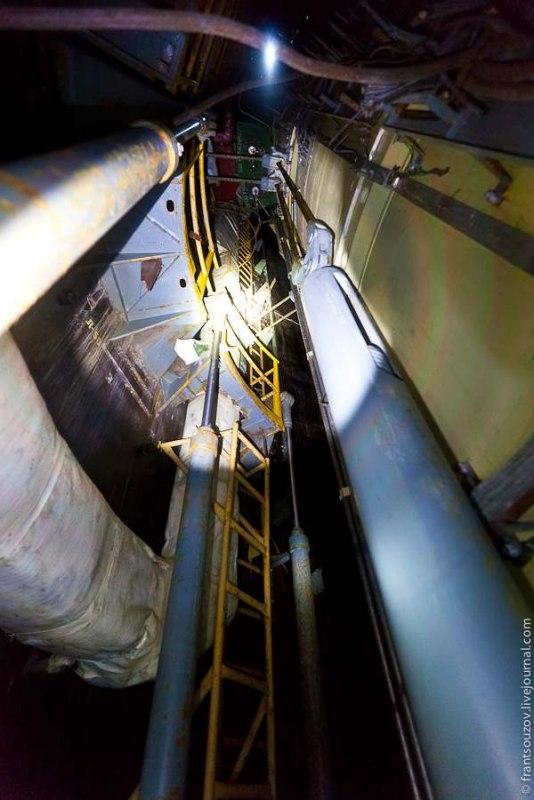
Once upon a time this place was top secret. Getting here was virtually impossible. And now he's just thrown ...

Well, as it turned out, inconspicuous "shed" can sometimes hide behind a lot of secrets.
Once out on the surface, we went home - impressions per day produced unreal amount.
via frantsouzov
A few days ago, we made a trip to this once top-secret facility, from which was to be launched nuclear missiles in the event of the Third World.

The military part looks deserted, the gates are open, but the road fresh traces of the tread. We go inside.

Hall of Fame. 40 years, this part of the protected world.

6. Construction of a room where a kitchen, barracks, the top has a glass bunker.
Penetrates through the open window.

We pass through the building, past the rooms where once lived the military. At the end of the building - wooden door with a modest sign "Poterna №1» and stairs down. On the wall - arrow indicating the direction of the UE. Somehow even uninteresting.

We go down, open the iron germodver and go further.

But it is not so simple. The corridor is flooded, then the depth of the water is waist-deep, especially not some fun ...

We rise to the surface and decide to look for another entrance. First we decided to check the guardhouse (right in the center, with a "glass" on the roof).
On the territory of many open technological wells and ventilation shafts, sprinkled with snow. We go to the track-to-track, testing the ground with a stick in front of him.

The guardhouse is equipped with a sauna with a swimming pool.

Then we come to the entrance to the shelter.

Inside, nothing particularly interesting, everything is "made to us."

The building unit, nourishes all of the electricity.

The equipment was taken for a long time.

Nearby are containers with diesel fuel for generators.

Moving around the territory. Periodically sink into the snow up to his waist, once almost got into a ventilation shaft (accidentally passed twenty centimeters from the edge).

Next in line - building №5, «room operator." House with no doors, only one window. In the ceiling hatch on the right can be seen the top, and down when something went staircase. Dilema - down right now, or to find another entrance.

Next door stands sentry point with a machine gun. However, to kazhy not just take off the internal alarm remeters was built underpass. In the semi - wooden hatch under it - round metal. However, since the construction is crooked - it is impossible to open it.

Well, there is only an inconspicuous "shed" at the bottom of the hill, from which we have just descended. We go into it.

Stairs down.

There awaits us germodver, corridors and some office space.

We go to one of them. The concrete platform suspended from the ceiling to the powerful shock absorbers feet from the floor.

This is to ensure that the equipment is located here, not out of order as a result of the shock wave.

Wardrobe and shock better. Fasteners such capital. I think we're on the right track.

Plates are suspended over the water, the surface of which is painted with chemistry in all colors of the rainbow.

Again inspection gallery. Go ahead.

Severe "military" snowdrift. Ironically, it was just a ruined building Refrigeration Center.

For normal operation of equipment required significant cooling, because next to the gearbox is a huge building with air conditioning and heating system in winter. In the case of the destruction of the building, air conditioning, cooling equipment is taken offline, this advance is frozen 35 tons of ice, a kind of cold accumulator.
Making his way through the debris to fall into another corridor, which lies on the floor tiles. You're a little bit!

At the end of the corridor - the first germodver. The inscription - not to take offense if caught.

Behind it - the second germanium, even more powerful, that once locked actuators.
Before the trip, we read that some freaks installed at the entrance of a homemade banner, on which someone was blown up. So it is necessary to open the door with extreme caution ...

For the second herma is a third, and after it - a "bridge" leading to cover PPC !!!

To understand what this Mahina - this photo from Ukrainian Museum of Strategic Missile Forces.
The command post was used for the management and control of launchers of intercontinental ballistic missiles 15A35 (NATO classification - SS-19 "Stiletto"), maintaining the temperature and humidity conditions, and protection of personnel from the damaging factors of WMD.

PPD is a standard missile silos depth of about 40 meters, within a 12-storey "building" metal capsule length 33 and a diameter of 3, 3 meters, suspended on vertical and horizontal shock absorbers.

"Ahrenet can!»

We are located on the "roof" of the capsule. The walls of many niches here and there are technological shaft leading to the surface. Some of them have served to communicate with the "outside world."

The command post of the regiment led by ten missiles, mine-launchers (MSE) which is on a distance of 8-10 km from each other.
The point has been linked with cables still 9 points that make up the division. Communication with the headquarters, district, Moscow carried out by means of a terrestrial antenna, ground antenna, and another backup cable underground antenna size of 100x100 meters, a buried under the ground to a depth of one meter. The launch can be done from anywhere in the division, district or from Moscow - depending on the situation.

Directly below me - 12 floors of the capsule, leaving the ground. Height is very rather big!

On the wall hangs a lot of stairs, some stationary, some with hooks above - portable. This is to ensure that in the event of a collapse of one or more fixed ladders in personnel still left open the possibility to get to the surface through an emergency exit hatch.
Well, we begin the descent!

Capsule is made in Leningrad, the site delivered fully assembled, except for sections 1 and 2 (equipped with diesel generators), which were transported separately in a vertical position.

All of this gigantic machine of hung on the walls of just such high-power cables, shock absorbers.

The third compartment. Each level - a round room in which the equipment safely carry out their functions in any conditions of the environment. It once housed communications equipment.

Down here is such a temporary staircase. In the fourth compartment was a system of automatic control and monitoring.

But as you have seen, "the world," the inhabitants of the capsule - the door just a narrow metal track leading along the circumference of the shaft.

We go down even lower.

In the fifth compartment is also in communication equipment.

Cabinet hardware.

Again down.

With all the responsibilities entrusted to the UE requirements it was also very high. The design has been able to withstand a direct hit of a nuclear warhead.
In that case, two officers who were on duty (and in the conditions of a real threat of war, or "elevated" readiness - three) had the opportunity to gain a foothold in a chair, as in the plane.
Technical excellence ensures livelihoods SAR personnel and combat missions for launching missiles in all conditions. There's even a standalone mode of operation in the event of failure of the external power supply.
People could be buried up to 45 days - it was at the command post of supply of food, equipment and other special equipment needed in an emergency.

At 6, 7 and 8 are located inside the power supply apparatus ensuring all objects UE and outside were attached compressed air cylinders.
According to one version, they were intended to breathe personnel - those who are "lucky" to survive to strike back at the enemy.

According to another - compressed (which is compressed and not liquefied) air used for pneumatic control mechanisms.

9 and 10 levels - the equipment to ensure the combat missile launches.

Outside are kilometers of wires, much has been injury.

If you look to the right of the yellow ladder guides are visible - once there was a lift (as it is seen on the model) by means of which you can get to any floor of the capsule.

And now, when there is no elevator, it is necessary to move in this way.

We continue downhill.

Cylinder pressure - 400 atmospheres. Very, very much!

The bottom can already be seen. We are thinking about how to go down even lower.

Well, almost the bottom. We see a lot of shock absorbers supporting and lying on the floor trash and fittings.

11 level - the command post to battle stations, remote control and monitoring of ASBU and communication. Here's how it looked once (Photo from the site of the museum).
In the last (twelfth) level is the lounge on duty shift.
Three fighting crew command post missile regiment on duty there at 6:00 clock. During this time, they had to constantly keep track of all the changes on the display of combat control.
Launch rocket could at least 2 people, as it was necessary to simultaneously rotate the two keys to unlock the main and secondary remote.

Here's how PPC looked from above - 120-ton lid seals the mine shaft and protect the capsule from the damaging effects of nuclear weapons.
Nearby there are several technological holes for emergency exit hatch and antenna connection.

Backup satellite communications antenna near the lid missile silo at the Museum of Strategic Missile Forces.
In the case of destruction of a rocket could launch several backup methods:
- Via a wired connection to another UE.
- If the cable is damaged, via satellite from another UE via the antenna Z (pictured).
- If this is damaged satellite, behind it there is another backup, disguised, large diameter.
- If all the links are damaged - in manual mode, directly from the silo. Near the mine there is a hatch with an electronic combination lock. An officer could go down into the mine through the door and give the command to start. The launch was carried out in 5 minutes after the command.

Another antenna (pictured was she) appeared after the modernization of the complex and served as a signal for making the start command missiles (Perimeter System - implementation of the "Doomsday Machine»).
In the event of a massive attack it was able to decide on a retaliatory strike on their own, without (or with minimal) human.
Upon receiving the signal from the system of missile warning, the first person in the country could activate the "Perimeter" and calmly expected developments, while being in full confidence that even the destruction of all who have the authority to bestow the command of the response to the attack, could not prevent the blow retribution.
The existence of such a system is sometimes referred to as immoral, but it is essentially the only deterrent to giving the real guarantee of failure of a potential enemy from the concept of a devastating pre-emptive strike.

Bottom view.
125 tons. 33 meters. 45 days battery life, regardless of what is happening on the surface. And this huge machine of a height of 12 floors in front of me hanging on the ropes.
When you realize how crazy was invested in its development, how much work and money - in its creation, and all that - for the sake of peace in the world ...

Once upon a time this place was top secret. Getting here was virtually impossible. And now he's just thrown ...

Well, as it turned out, inconspicuous "shed" can sometimes hide behind a lot of secrets.
Once out on the surface, we went home - impressions per day produced unreal amount.
via frantsouzov















